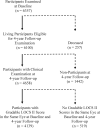Four-year incidence and progression of lens opacities: the Los Angeles Latino Eye Study
- PMID: 20181327
- PMCID: PMC2867354
- DOI: 10.1016/j.ajo.2009.11.012
Four-year incidence and progression of lens opacities: the Los Angeles Latino Eye Study
Abstract
Purpose: To estimate the 4-year incidence and progression of lens opacities.
Design: Population-based longitudinal study.
Methods: A total of 4658 adult Latinos from Los Angeles County were examined at baseline and 4-year follow-up. Examination included assessment of lens opacities using the Lens Opacities Classification System II (LOCS II). Incidences of cortical, nuclear, and posterior subcapsular opacities (with LOCS II scores >or=2) were defined as opacity development in persons without that opacity at baseline. Single and mixed opacities were defined in persons without any opacity at baseline. Incidence of all lens changes included development of at least 1 opacity or cataract surgery among those without any opacity at baseline. Four-year progressions were defined as increase of >or=2 in LOCS II score.
Results: The 4-year incidence of all lens opacities was 14.2%. Four-year incidence of cataract surgery was 1.48%. The incidences were 4.1% for cortical-only, 5.8% for nuclear-only, 0.5% for PSC-only, and 2.5% for mixed. The incidences for any opacities were 7.5% for cortical, 10.2% for nuclear, and 2.5% for PSC. Incidence increased with age (P < .0001 for all). The progressions were 8.5% for cortical, 3.7% for nuclear, and 2.9% for PSC opacities.
Conclusions: Our Latino population had a higher incidence of nuclear than cortical opacities, but a greater progression of cortical than nuclear opacities. Incidence and progression of PSC was low. Additional understanding of the natural history and progression of various lens opacities will give us a better understanding of the pathogenesis and management of lens opacities.
Copyright 2010 Elsevier Inc. All rights reserved.
Figures
References
-
- Pascolini D, Mariotti SP, Pokharel GP, et al. 2002 global update of available data on visual impairment: a compilation of population-based prevalence studies. Ophthalmic Epidemiol. 2004;11:67–115. - PubMed
-
- Congdon N, O'Colmain B, Klaver CC, et al. Causes and prevalence of visual impairment among adults in the United States. Arch Ophthalmol. 2004;122:477–85. - PubMed
-
- Salm M, Belsky D, Sloan FA. Trends in cost of major eye diseases to Medicare, 1991 to 2000. Am J Ophthalmol. 2006;142:976–82. - PubMed
-
- McCarty CA, Mukesh BN, Dimitrov PN, Taylor HR. Incidence and progression of cataract in the Melbourne Visual Impairment Project. Am J Ophthalmol. 2003;136:10–7. - PubMed
-
- Klein BE, Klein R, Lee KE. Incidence of age-related cataract: the Beaver Dam Eye Study. Arch Ophthalmol. 1998;116:219–25. - PubMed
Publication types
MeSH terms
Grants and funding
LinkOut - more resources
Full Text Sources
Medical


